|
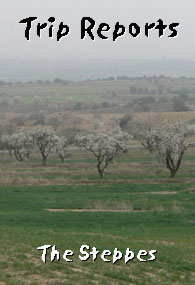 |
||||||||||||||||||||||||||||||
TRIP REPORTS: |
|||||||||||||||||||||||||||||||
Trip reports from participants of Catalan Bird Tours' birding holidays and bird watching tours to The Steppes will be posted here.My own blog and photos are also below. |
|||||||||||||||||||||||||||||||
For more Trip Reports: |
|||||||||||||||||||||||||||||||
Date |
Author |
Clients |
|
||||||||||||||||||||||||||||
|
20 october 2006
|
|
|
|||||||||||||||||||||||||||||
20 October 2006 |
Stephen Christopher |
Ann & John Hawke, England |
|||||||||||||||||||||||||||||
“The day we spent together was well worth the entrance fee and we thoroughly enjoyed it – even the rain!We would never have thought of going where you took us. Your knowledge of which species were where was as good as expected – and we expected a lot!We could not do justice to the meal – not only varied and ‘local’ but at a very reasonable price. Thoroughly enjoyable.”John and Ann Hawke
|
|||||||||||||||||||||||||||||||
|
Great Bustard
|
Little Owl
|
||||||||||||||||||||||||||||||
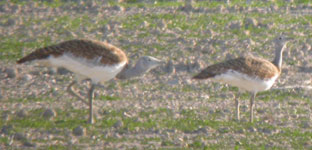 |
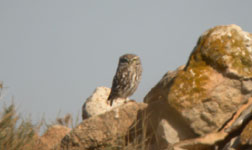 |
||||||||||||||||||||||||||||||
|
27 july 2006
|
|||||||||||||||||||||||||||||||
27 July 2006 |
Stephen Christopher |
Max Andrews, Spain |
Steppes, Llobregat, Garraf |
||||||||||||||||||||||||||||
As Max felt he hadn’t done enough birding over the year since he moved to Barcelona, he requested a marathon day, taking in the wetlands of Delta Llobregat, the mountains and coast of the Garraf Massif and, during the cooler morning when its birds are much more active of course, The Steppes of Lleida.And it was one of Lleida’s famous White Storks that welcomed us first as we approached the peaje, or toll. The population here is endemic, growing in number and, increasingly, preferring the sedentary life rather than over-wintering in Africa. This apparent compliment, incidentally, was rewarded a few years ago when the town’s people, who take much pride in their guests, installed heating in the city centre’s nests.Once installed ourselves it wasn’t long before, using the car as a mobile hide, we were able to encroach into the personal space of Crested, Calandra and Short-toed Lark, one of the latter even popping up on an adjacent mound of earth in a moment of mutual curiosity. The dozens of Black Kites dotted them selves across the sky significantly later than usual I thought but both Woodchat and Southern Grey Shrikes were reliable and predictable, posted like bush-top sentries throughout the morning. Red-legged Partridge quick-stepped out of reach, towing gaggles of clumsy young scuttling and bouncing behind as if attached by elastic strings.It’s no secret that, over the past few decades the expansion of the fruit-growing industry has been one of the main threats to Catalonia’s steppe birds. So it’s ironic that our first encounters, as on my last few visits, with Stone-Curlew and Pin-tailed Sandgrouse were in the fallow fields bordering one particular orchard. Here also we were treated to Hoopoe, Turtle Dove and an iridescent Roller.A short stop off at a riparian copse, via La Timoneda, produced Thekla Lark, Golden Oriole, Bonelli’s Warbler and Short-toed Treecreeper but the Red-necked Nightjars that I’d seen here on recent previous visits, including the week before, didn't materialise.Then, with the sun rising high, we decided to head back towards Barcelona and sit out the heat in one of the hides at the Llobregat Delta, which we did, but not before sightings of Blue Rock Thrush, Red-rumped Swallow and, perched on an old pigeon coop, a small family of Lesser Kestrel. |
|
||||||||||||||||||||||||||||||
|
Stone-curlew
|
Lesser Kestrel
|
||||||||||||||||||||||||||||||
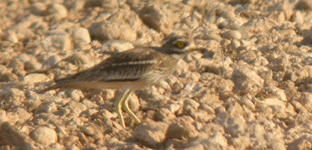 |
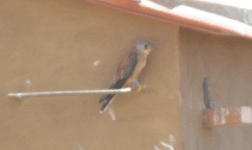 |
||||||||||||||||||||||||||||||
|
17 february 2006
|
|||||||||||||||||||||||||||||||
17 February 2006 |
Stephen Christopher |
clear, bright, sunny but windy |
|||||||||||||||||||||||||||||
|
Having arrived early for a first meeting with Steve West, author of ‘Where the birds are in NE Spain’, I sat quietly in the car listening to the Linnets and White Wagtails fussing around a small watering hole along an approach road to the Alfés timoneda. ‘If Pin-tailed Sandgrouse flock to watering holes so routinely', I mused, 'how come they were so hard to pin down in a habitat famous for being dry?’ and made a note to ask Steve, who’d emigrated to Lleida over eighteen years ago. Meanwhile, as the car purred its way into the sunrise, passing Crested Lark and Corn Bunting, I decided to take advantage of some fortuitous spare time and digiscope the restless but ever-closer Calandra Larks (see below) a species that, though initially wary, do seem to tolerate invaders rather quickly and they began posing and singing for me on any low bush they could get their claws on. It’s not that I’m a bad photographer honestly but, of course, the minute I had set up the scope, screwed on the adaptor, attached the camera, turned it on, focussed and rested my finger on the shutter-release, they teasingly flitted down into the timoneda, a habitat incidentally made up of low aromatic bushes (predominantly thyme, hence its name). Exactly on time, Steve arrived and we immediately began discussing the threat from expanding fruit farming and irrigation to this unique habitat and especially to one of its rarer guests, the Dupont’s Lark. It’s at this time of year that they begin their distinctive nasal mating song and we wondered if Lleida had heard the last of it, such is the seriousness of the threat posed. As it turned out, we’d have to wait for another day to find out though; perhaps we came a little too early in the year. Perhaps. For the next couple of hours we chatted and moaned our way through Thekla Lark, Pin-tailed Sandgrouse, Red-billed Chough, Red-legged Partridge, Little Owl, Black Redstart and a small group of flushed Little Bustard. And a fleeting visit to the reservoir at Utxesa added Yellow-legged Gull, Marsh Harrier, Penduline Tits and Southern Grey Shrike before we parted company. I was disappointed only that I hadn’t spied my first Great Spotted Cuckoo of the year, as they do arrive as early as February, but on the way out I was treated to a final close look at the feeding flock of Pin-tailed Sandgrouse. Apparently, there are enough watering holes around to still make them difficult to find. And, today at least, the wind certainly makes them difficult to photograph (see below). Well that’s my excuse anyway. |
|||||||||||||||||||||||||||||||
|
Calandra Lark
|
Pin-tailed Sandgrouse
|
||||||||||||||||||||||||||||||
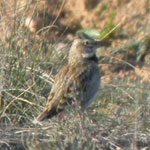 |
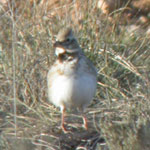 |
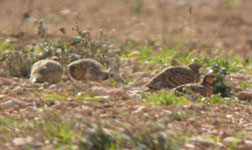 |
|||||||||||||||||||||||||||||
|
|||||||||||||||||||||||||||||||
